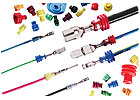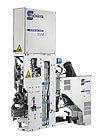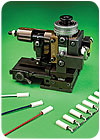
Some of what’s new in wire termination equipment these days is actually old.
“ETCO has been in business for over 50 years, and I’m seeing a lot of our legacy equipment being resurrected,” says Chris Gravel, applications engineer with ETCO. “People are asking for parts for applicators that we haven’t seen in years-equipment that was built in the ’70s.”
Gravel blames the recent economic downturn for flooding the market with used equipment. He also believes that a growing amount of wire harness assembly is moving back to North America from China and India.
The latter trend, while welcome, is putting pressure on suppliers of wire termination equipment to make their equipment easy to operate. When OEMs began outsourcing harness assembly overseas, domestic assemblers lost much of their home-grown expertise in wire termination processes. Now that harness assembly is returning to North America, some contract manufacturers are finding themselves back at the head of a learning curve.
“Manufacturers are looking for machines that aren’t that complicated to operate,” says Bob Grenke, global product manager for application tooling at Molex Inc. “Since crimping can be operator-dependent, manufacturers are looking for error-proof equipment.”
For example, when using the new handheld, battery-powered crimp tool from Molex, the operator inserts a loose terminal into the crimp head. The tool automatically holds the terminal in place for optimal installation, eliminating operator judgment. When the tool is actuated, the head retracts and does not return to the starting position until the maximum crimping force has been reached, ensuring consistent crimps.
The tool terminates wires up to 10 AWG, and a range of modular crimp heads and die sets is available. The crimp head rotates 360 degrees to access hard-to-reach positions.
Error-proofing technologies have also been applied to semiautomatic and fully automatic wire termination equipment. The most important of these is an integrated crimp quality monitor that measures force, height and position.
“They’re extremely sensitive,” says Gravel. “They can detect one wire strand missing from a crimp. We recently supplied the terminals and equipment to assemble wires for an air bag sensor. Every machine had to have a crimp force monitor.”
One terminating machine with an integrated crimp quality monitor is the Amp-O-Lectric Model G from Tyco Electronics. The machine issues an alarm and stops cycling when a crimp falls outside preset parameters. The operator must then push the reset button to continue.
Applicators can be changed without tools. Crimp height can be adjusted manually in 0.0005-inch increments over a range of 0.018 inch. Alternatively, the machine can automatically configure itself by reading a chip installed on certain applicators.
The control system enables the operator to power the motor on or off, jog forward or reverse, switch to split-cycle operation, turn the work light on or off, power the air feed on or off, or reset the batch counter.
The modular, direct-drive machine can be operated independently or be integrated into a fully automated line. An optional module is available to strip the wire prior to crimping.
While crimp quality monitors are excellent at detecting faulty crimps, they don’t necessarily prevent a poorly crimped wire from being accidentally placed among good product. It’s up to the operator to put the defective wire into a reject bin.
Some equipment takes even that step out of the operator’s hands. For example, crimping presses from Schaefer Technologies LLC are equipped with cutters that automatically destroy poorly crimped connections as soon as they are detected and before the wire is released.
“Of course, there’s no way to rework the wire once that happens, but if you want to guarantee everything coming off the machine is good, that’s the way to go,” says Wyatt George, vice president of sales at Schaefer Technologies.

Designed to be integrated into a fully automatic processing line, this module applies a rubber seal to the end of a stripped wire prior to crimping. Photo courtesy Schaefer Technologies LLC
Big and Little
In addition to error-proof equipment, suppliers are seeing increased demand for machines to process small connectors and thin wires.Thin wires can be hard to handle in fully automatic termination lines. When a thin wire is swung into place for termination, the sudden stop can cause the wire to oscillate. That makes it hard to insert the wire into the applicator.
“The best thing to do is slow that movement down prior to reaching the crimp area, so it can be placed more accurately,” says George. “Our new Megomat 1000 has that feature.”
In fact, wires are getting so thin, that George fears today’s crimp quality monitoring technology could become obsolete. “Eventually, we’ll reach the point where the amount of force needed to crimp the connection will be so small that the crimp force monitor will be triggered by the rotation of the ram drive or the noise of the press,” he explains. “The monitor won’t be able to read anything. It’s going to be a problem detecting bad or missing crimps.”
Thick wires also present a challenge for fully automatic processing lines, which are not always able to accommodate the big die sets needed for crimping. Recently, ETCO introduced a smaller version of its applicator for ignition wire terminals. The applicator was designed specifically for fully automatic cutting, stripping and terminating systems, such as the new MTX-Ignition Wire from Artos Engineering Co.
Seal applicators are another growth area for suppliers of wire termination equipment. Schaefer recently introduced its SSM module for applying seals to the ends of stripped wires prior to crimping. Designed to be integrated into fully automatic processing lines, the module can apply both soft and hard seals. It can handle seals in myriad shapes and sizes, up to 10 millimeters in diameter and 9 millimeters long. With special tooling, it can process seals up 17 millimeters in diameter and 16 millimeters long.
The seals are fed in bulk and supplied to the pickup point on a track. A pin goes into the seal and stretches it wide enough to slip it over a tube. When a wire enters the tube, the seal is pulled off the tube and onto the wire.
“You can strip the wire before or after placing the seal,” explains George. “We do it after. The problem with doing it before stripping is that then you have to find the position of the seal. You don’t want to cut the seal.”

This applicator is for crimping fire-retardant insulated disconnects. It can produce 5,000 terminations per hour. Photo courtesy ETCO
Ten Tips for Extending the Life of Your Press and Applicator
1. Keep all moving parts lubricated.2. Keep applicator free from pieces of wire and scrap.
3. Do not overtighten screws when making adjustments.
4. Always turn press over by hand to ensure correct alignment of tooling before power up.
5. Polish the roll tool and change worn tooling.
6. Keep extra sets of perishable tooling on hand to avoid production delays.
7. Do not modify tooling when there’s a problem. Call your factory representative.
8. Refer to crimp height requirements on the applicator tag or instruction manual before making adjustments. Overstriking a connection could damage the equipment.
9. Secure your manuals for future reference.
10. Before making adjustments or attempting to correct a problem, refer to the manuals for the press and applicator.
Source: ETCO
ASSEMBLY ONLINE
For more information on wire termination, visit www.assemblymag.com to read these articles:*Wire Processing: Crimping Loose-Piece Contacts.
*Crimp Force Monitoring.
*Making Contact.




